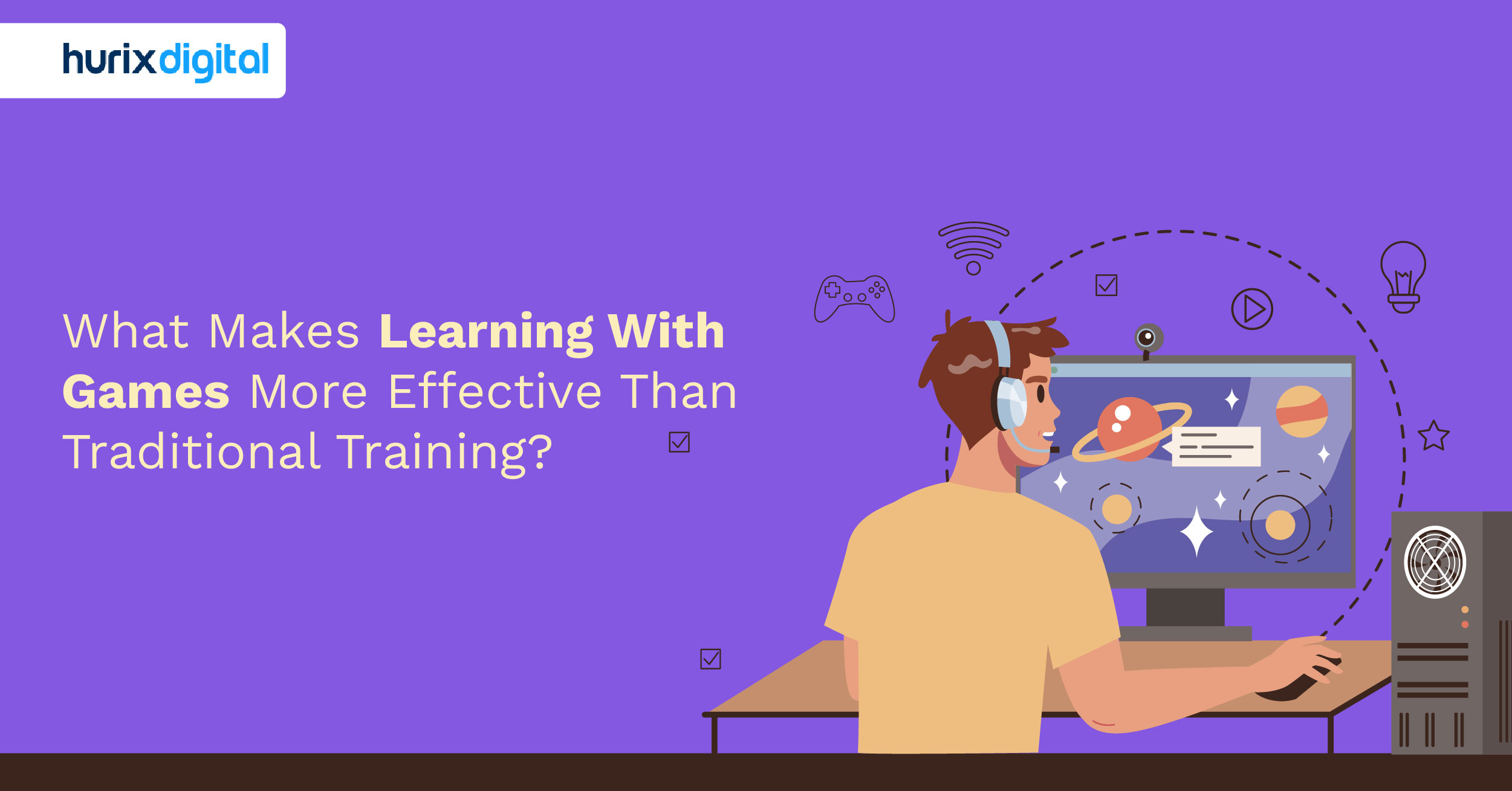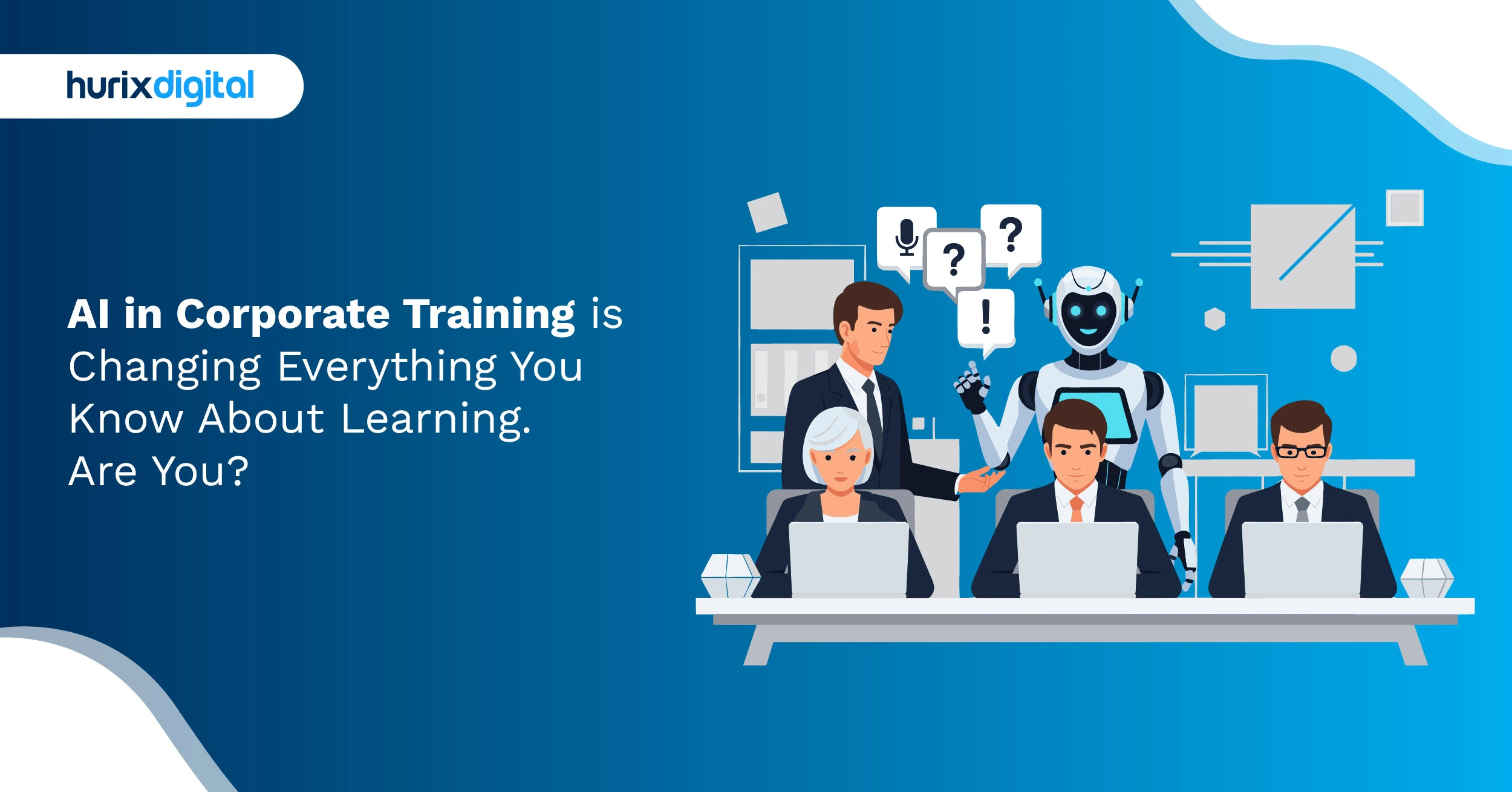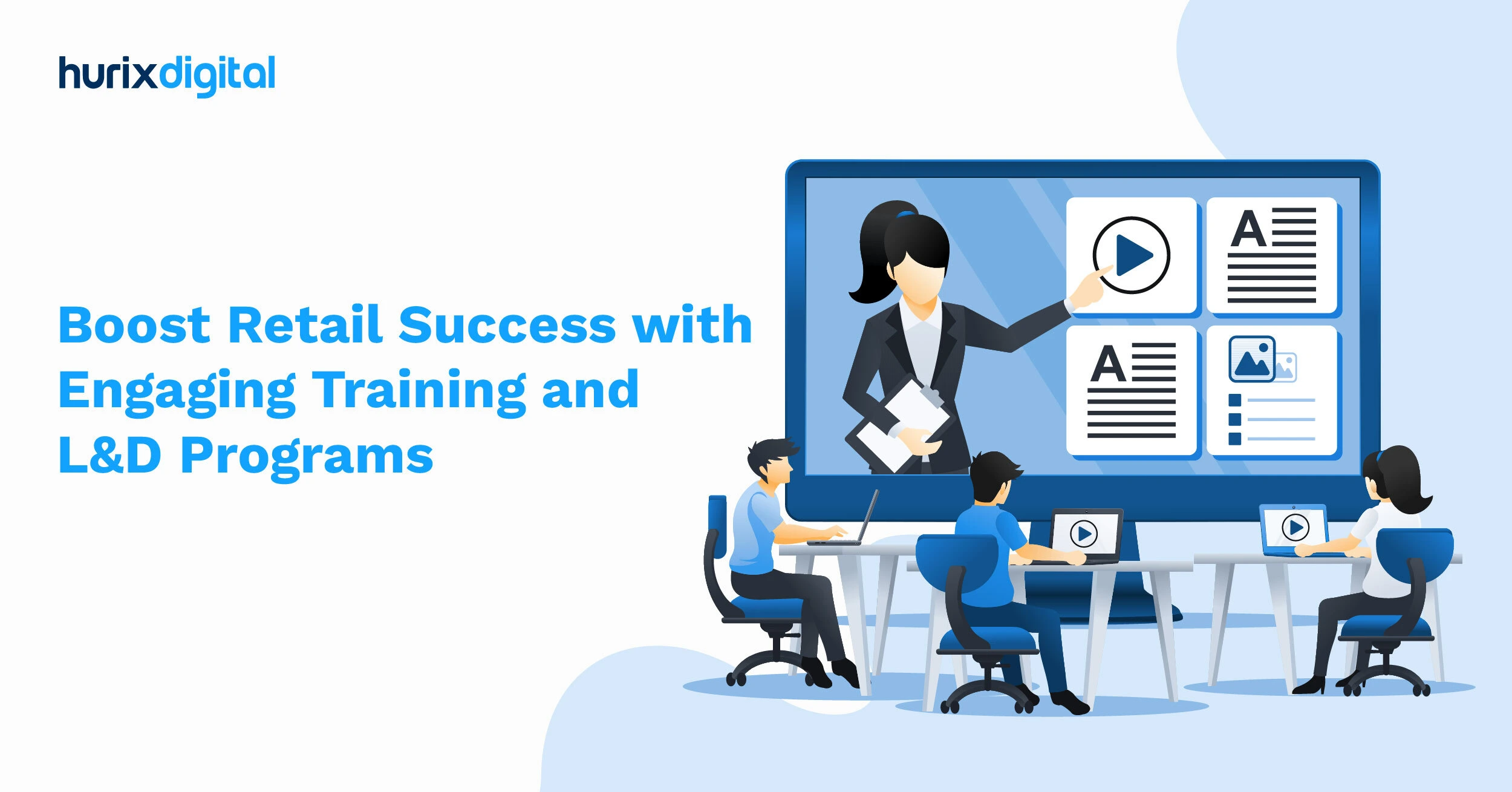
Boost Retail Success with Engaging Training and L&D Programs
Summarize with:
This blog explores how gamification, targeted training, and robust L&D strategies transform retail training programs. Learn how these approaches improve employee performance, tackle common training challenges, and drive customer engagement.
The retail sector presents a balancing act. The situation constantly changes, and employees must be highly skilled and flexible. According to a report from Deloitte, 77% of leaders see that having a well-trained workforce is crucial for attaining business prosperity.
However, the past few years have been very challenging for retail workers. Most of them are undergoing unmanageable stress levels, courtesy of short-notice shift changes and more responsibilities.
Innovative solutions and technology play a critical role in keeping them engaged. By embracing technology such as AI-driven training and online learning platforms, retailers can bridge the gap faced in the retail sector.
Retail companies need to build a sustainable, tech-driven, data-centric retail training program framework to equip workforces with important skills continuously.
Table of Contents:
- Key Challenges in Retail Training Programs
- Developing Engaging Training Content
- 6 Pillars of Superior Retail Training Programs
- Benefits of Tech-Enabled Retail Training Programs
- How Gamification Induces Higher Customer Engagement in Retail?
- Uses Augmented Reality for Engaging Customers
- Implements High-End UX and UI for Brand Recognition
- Employs Rewards and Challenges within Games for Elevated Customer Retention
- Drives Specific Consumer Behavior
- Helps in Providing a Personalized and Interactive Experience
- Heightens Motivation for User Involvement
- Final Thoughts
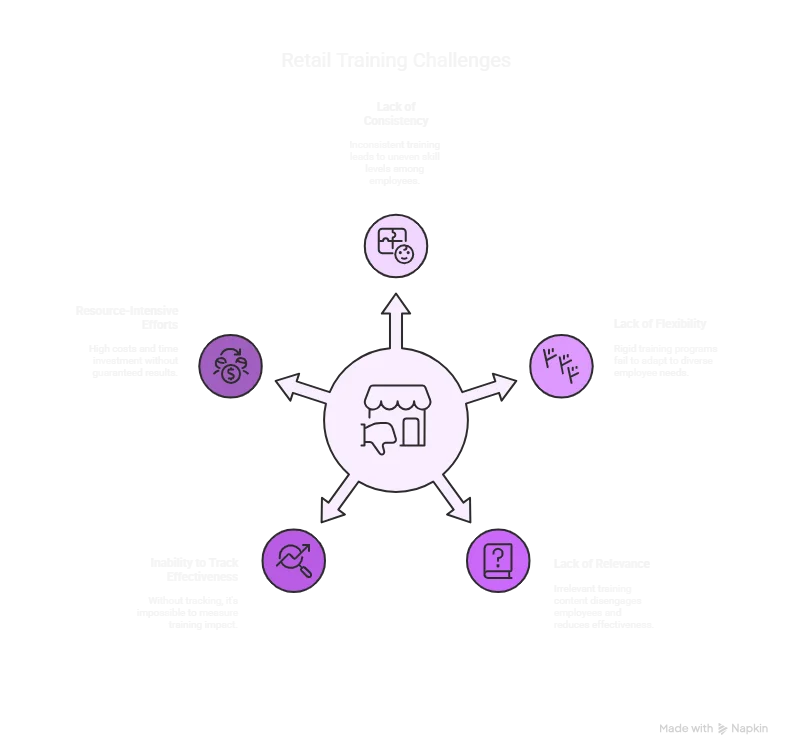
Key Challenges in Retail Training Programs
Training programs are a vehicle by which companies can engage in employee development through skill building. Retail workforces may be trained on various aspects, such as:
- Products
- Specific domain functions
- Processes
- Usage of tech platforms that automate and efficiently function
However, companies struggle with several challenges as follows:
1. Lack of Consistent Employee Training
Companies tend to host training when they sense drastic market shifts or in times of crisis.
When this is the case, productivity drops drastically because not all employees can absorb and retain learning quickly enough. Instead, employee training must be a proactive (not reactive) process so that teams can respond quickly to new market conditions.
2. Lack of Flexibility
Traditional training methods, i.e., lecture-style onsite training, do not offer learning flexibility. Employees need to disrupt their work schedules to attend training.
Lack of flexibility may lead to a lack of training bandwidth, so employees may stop attending sessions altogether.
3. Lack of Training Relevance
Companies that deliver one-size-fits-all training programs may observe low learning effectiveness. Training must be relevant to an employee’s specific skill sets, strengths, and potential to make them highly productive.
4. Inability to Track Training Effectiveness
Companies may lack the technology to track training effectiveness with real-time data. Lack of access to data diminishes training efforts, making it challenging to know an employee’s progress consistently in real-time.
5. Resource-Intensive Efforts
Traditional training methods required investment in resources such as facilitators and trainers, physical space to conduct training, and training session design.
This approach consumes financial resources and human bandwidth, making it challenging to make employee development a sustainable effort.
Developing Engaging Training Content
Overcoming the hurdles of geographically dispersed workforces and busy employee schedules requires a two-pronged approach: leveraging technology for delivery and creating engaging training content. Hence, we answer an important question: How should training content be developed?
Here’s a table outlining effective strategies for creating engaging training content for retail employees:
| Strategy | Description |
| Tailored Content |
|
| Microlearning Modules |
|
| Interactive Elements |
|
| Gamification Strategies |
|
| Scenario-Driven Training |
|
| Supporting Staffs |
|
While technology offers excellent tools for accessibility and flexibility, engaging content is the heart of effective training tools.
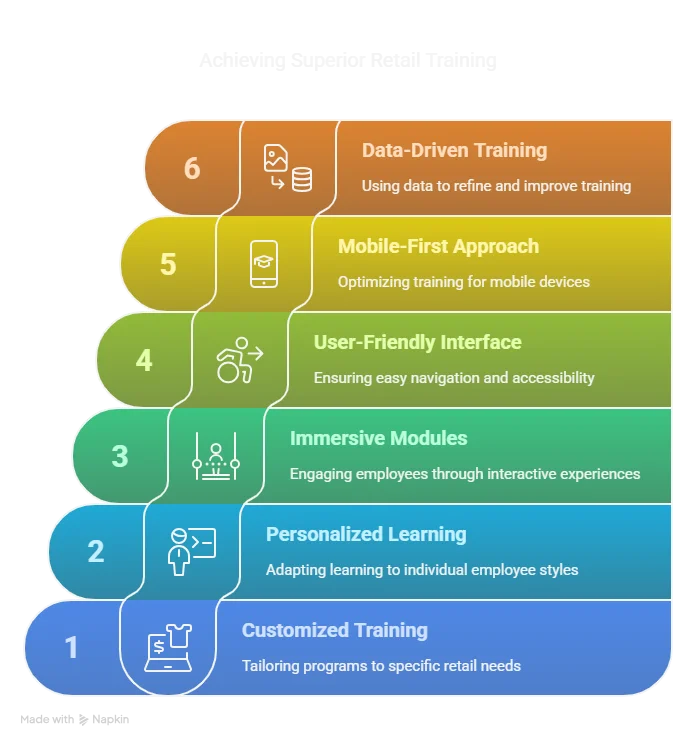
6 Pillars of Superior Retail Training Programs
Here’s a snapshot of how retail training programs can become relevant, engaging, and effective:
1. Customized Training Solutions
Every company has a unique business model. Thus, employee training must also be customized.
For instance, a large chain of offline retail supermarkets looking to build an online footprint has different needs from a Direct-To-Consumer business that’s accelerating growth.
Companies must identify the right mix of blended learning, instructor-led training, and eLearning to make training relevant.
2. Personalized Learning Approach
The old thinking was that training could be conceptualized and delivered en masse.
But today, training is more effective when it is personalized and responsive to an employee’s performance. Feedback must be personalized and very specific.
3. Immersive Training Modules
Retail training programs must have a good dose of hands-on learning.
The use of Extended Reality (XR) technologies like Virtual Reality (VR) and Augmented Reality (AR) can be leveraged to deliver industry-specific simulated learning experiences that prepare employees for real-world scenarios.
4. A User-Friendly Interface
Usage of a cloud-based, Artificial Intelligence (AI) powered Learning Management System (LMS) interface simplifies the entire training process.
It allows easy employee onboarding, creation, and secure distribution of on-demand learning resources, video conferencing facilities, and access to detailed data insights.
5. Mobile-First Approach
With more employees using mobile as their primary mode of communication and learning, companies must deliver mobile-optimized content and sessions.
Employees must be able to log in anytime, from anywhere, and start learning as per their schedules.
6. Data-Driven Training
Access to real-time data analytics is a pillar of effective modern retail training programs. Companies must have access to data on aspects such as:
- Employee learning patterns
- Usage of on-demand resources
- Performance in assessments and live simulations
- Impact of coaching sessions
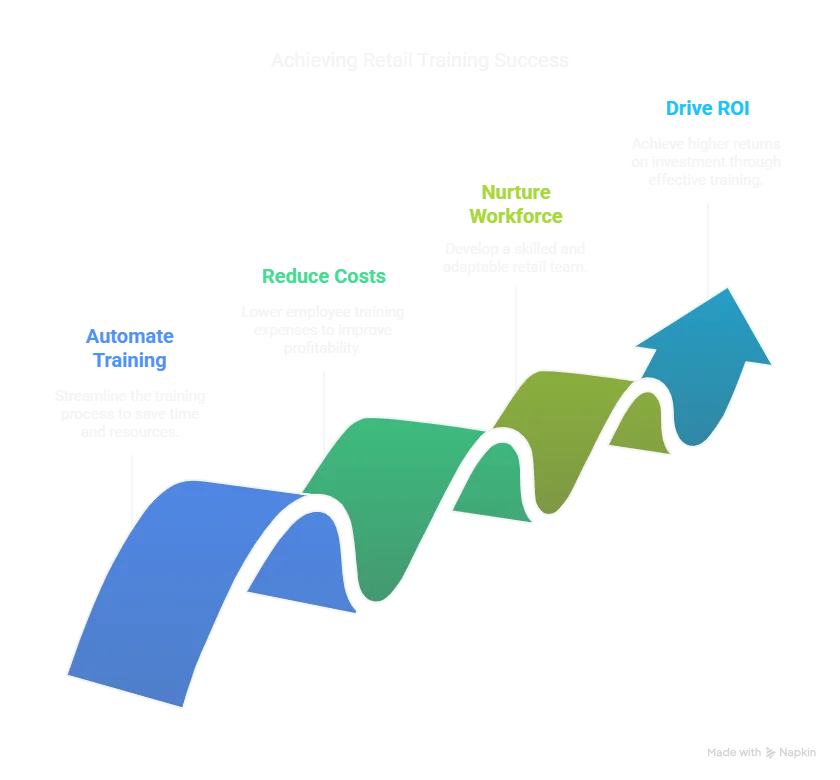
Benefits of Tech-Enabled Retail Training Programs
The usage of superior LMS solutions enables businesses to drive more impact in their retail staff development programs.:
1. Automate the Entire Training Process
The use of a single, unified LMS interface allows learning and Development (L&D) teams can automate the entire training workflow – from onboarding employees and creating courses to delivering new training programs quickly.
Training initiatives can be launched on time, and human-intensive efforts can be reduced. L&D teams can invest more time in strategy and less in manual processes.
2. Reduced Employee Cost-to-Company
In the US, over 63% of frontline retail workers think about quitting their jobs. Hence, it is not surprising that retail attrition is the highest among all sectors.
A major factor is the lack of opportunities to learn new skills and get on the growth track. Attrition increases the cost-to-company because hiring new employees is such an expensive undertaking.
Effective employee growth in retail can play an essential role in keeping workforce challenges and reducing attrition.
3. Nurture a Relevant Retail Workforce
Effective retail training programs ensure that employees have the skills to meet current and future challenges and workforce productivity begins to increase.
Employees feel more engaged and motivated to excel. Future leaders can be groomed from within the company to navigate the future of the business.
4. Driving Higher ROI
A well-trained and upskilled workforce can collectively contribute towards two key goals of every retail business – increased customer loyalty and reduced customer acquisition costs.
As retail employees become more customer-centric, both goals are achieved. This shift helps drive revenues and, in turn, grows the business’s profitability.
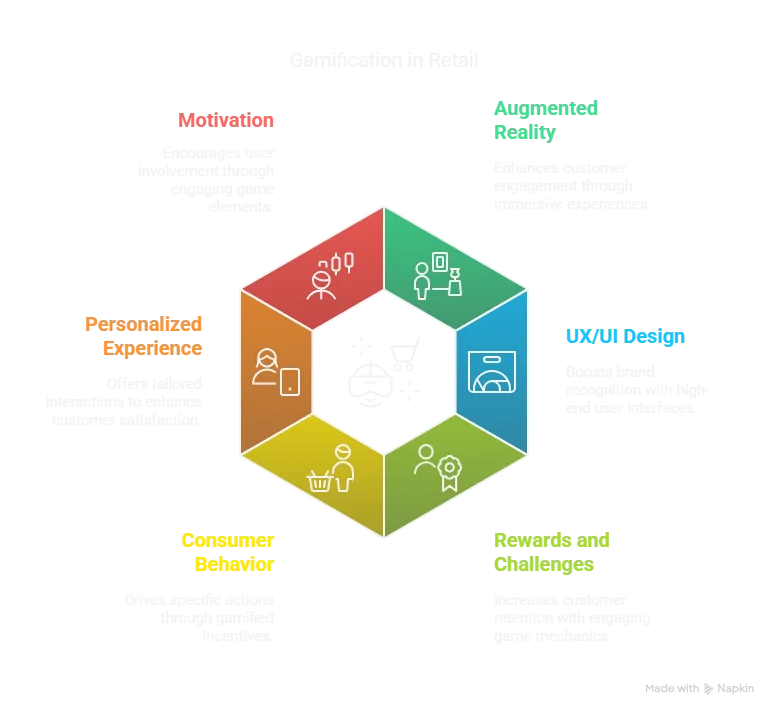
How Gamification Induces Higher Customer Engagement in Retail?
Gamification in retail improves the customer shopping experience by driving their attention and making it a fun and enjoyable process.
Here are a few ways gamification helps retain higher customer engagement:
1. Uses Augmented Reality for Engaging Customers
A trending technical development that has made a significant impact on the success of gamification in the retail sector is augmented reality (AR).
Retailers can use augmented reality (AR), which superimposes digital elements over the actual environment, to build immersive experiences that truly connect customers with their businesses.
Users can use apps when in the store to solve puzzles, play games, and collect virtual rewards. Customers are engaged and amused by this gamified augmented reality experience, which also motivates them to investigate other products and spend additional time on the brand app or store.
For example, Businesses like Lowe’s and IKEA have started implementing these technologies to improve their customers’ shopping experiences.
Additionally, augmented reality (AR) can enhance the changing room experience in a retail setting by enabling customers to view clothing from various perspectives and make well-informed purchasing decisions.
2. Implements High-End UX and UI for Brand Recognition
User Interface (UI) and User Experience (UX) are essential components of successful gamified applications.
While UI design concentrates on the application’s aesthetic appeal and effective user interface, UX design is critical in guaranteeing that users have a smooth and pleasurable experience.
Because users start to identify gamified apps with a company or brand, a well-designed UI/UX improves brand awareness and loyalty.
3. Employs Rewards and Challenges within Games for Elevated Customer Retention
A variety of gamification strategies are used to engage and motivate shoppers successfully. Rewards offer consumers a dopamine rush, which motivates them to do activities and interact with the brand more.
Examples of rewards include badges, scores, levels, discounts, and free offers. Customers are inspired to reach their goals and feel a sense of accomplishment when they see progress bars.
Additionally, challenges are effective instruments that steer clients toward desired behaviors and provide contextually appropriate experiences. Virtual or in-game money influences user behavior, boosts retention, and piques their desire for tangible gains.
Ultimately, gamified applications that create virtual worlds increase user engagement and motivate users to return to the app regularly.
4. Drives Specific Consumer Behavior
By developing a suitable incentive schema and publicizing it effectively, you can reward practically any desirable customer behavior that fits with your business goals.
This allows you to accurately track ROI based on these particular behaviors and user activity.
Gamification in retail is highly efficient in encouraging particular customer behaviors that marketers would like to observe, such as completing surveys, influencing referrals, generating contacts, and completing registration forms.
5. Helps in Providing a Personalized and Interactive Experience
You can include personalization into the very fabric of your engagement strategy by gamifying retail. Interactive games and challenges are a simple approach to getting direct personal data about customers’ shopping habits.
Retailers may better understand their customers’ interests and customize their offers and promotions by gathering and studying this customer data.
When executed well, this offers a feeling of uniqueness and personalization that builds consumer value. It lessens invasive and irrelevant messaging, fostering long-lasting partnerships and raising the lifetime value of customer relationship management.
6. Heightens Motivation for User Involvement
Gamification in retail is an effective strategy for boosting user participation because it emotionally engages people and motivates them to achieve their objectives.
Gamification features two kinds of motivation: extrinsic and intrinsic. When gamification is paired with financial incentives, it loses its effectiveness and beneficial effect as participants lack fulfillment and enjoyment.
However, extrinsic motivation, such as receiving a game-related discount shopping, enhances customer loyalty and contentment with the retailer.
If gamification and social interaction are integrated with marketing strategy, they have the potential to impact user behavior and encourage user engagement.
Final Thoughts
Tech-enabled, data-driven learning management systems are the retail sector’s future of learning and development. These systems allow learning to be automated and tracked in real-time.
A recent survey indicated that 80% of respondents preferred online shopping. However, it was interesting to note that in the offline mode:
- % of respondents prioritized quality
- % of respondents prioritized price
- % of respondents prioritized the payment facility
- % of respondents prioritized the salesperson’s advice
As consumers get more specific about their needs, due to the power of choice, businesses are under significant pressure to stay competitive. Retail companies are responding with innovative practices such as personalization, store-branded applications, virtual shopping experiences, and the use of augmented reality to attract customers.
The best approach for retailers is to partner with a technology specialist with a deep understanding of training needs. A tech partner must also have the capabilities to leverage technologies like AI, ML, automation, and virtual reality to deliver relevant solutions.
If your business aims to transform its retail training programs, Hurix Digital has the technology solutions to support your needs.
Get in touch with us to start a conversation.
Summarize with:

Senior Vice President – Business Development
at Hurix Digital, with over 25 years of experience in EdTech and workforce learning. He excels in business development, customer relationship management, and scaling digital learning solutions, driving global growth through innovative content, simulations, and AI‑driven training offerings
 Upcoming Masterclass | Build an Army of Brand Evangelists using Training & Development | November 20th, 8:30 AM PDT | 11:30 AM EDT | 10:00 PM IST
Upcoming Masterclass | Build an Army of Brand Evangelists using Training & Development | November 20th, 8:30 AM PDT | 11:30 AM EDT | 10:00 PM IST


